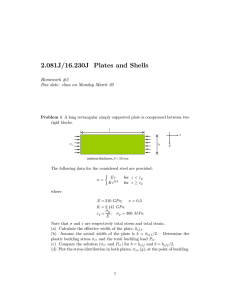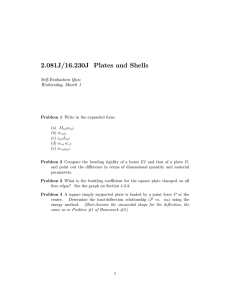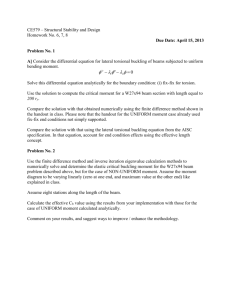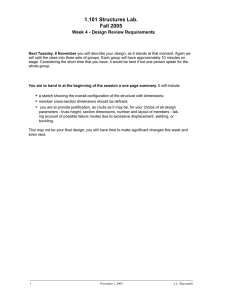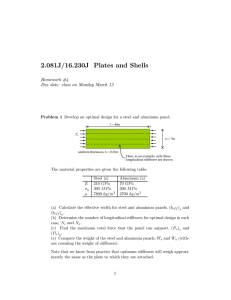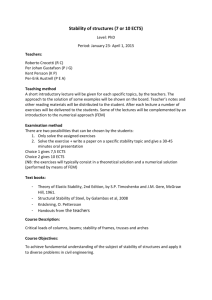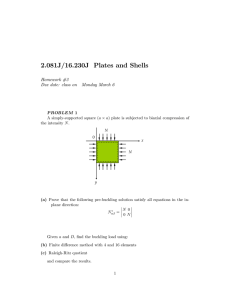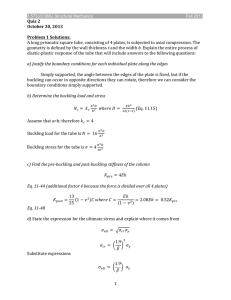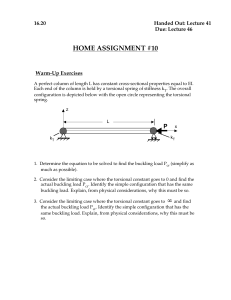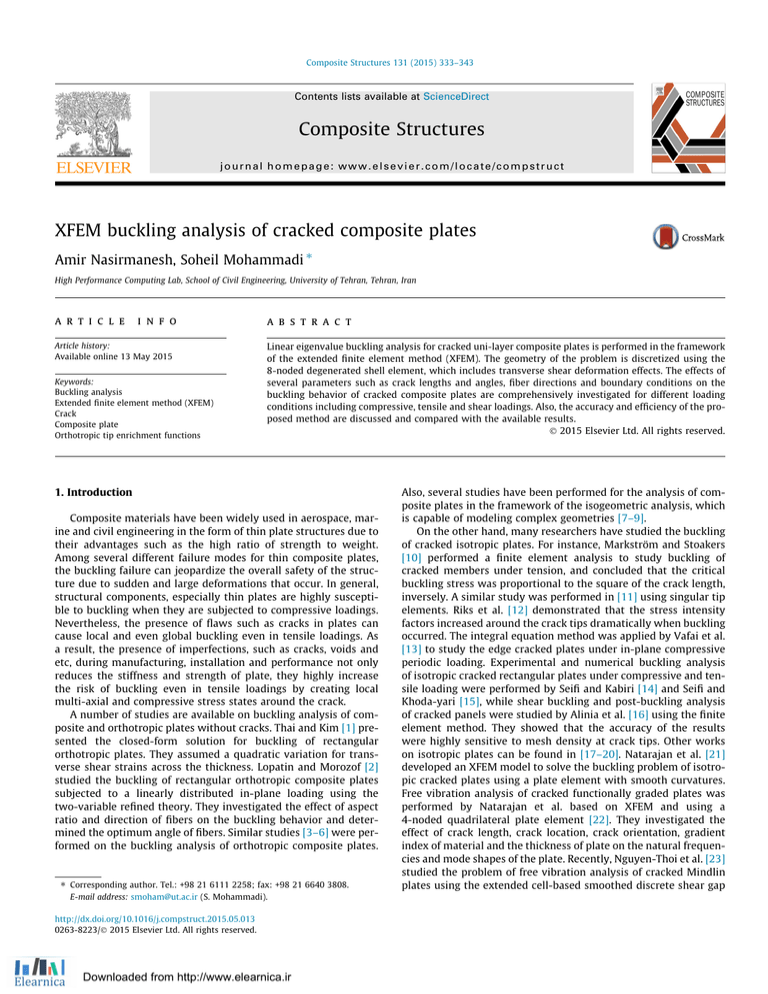
Composite Structures 131 (2015) 333–343
Contents lists available at ScienceDirect
Composite Structures
journal homepage: www.elsevier.com/locate/compstruct
XFEM buckling analysis of cracked composite plates
Amir Nasirmanesh, Soheil Mohammadi ⇑
High Performance Computing Lab, School of Civil Engineering, University of Tehran, Tehran, Iran
a r t i c l e
i n f o
Article history:
Available online 13 May 2015
Keywords:
Buckling analysis
Extended finite element method (XFEM)
Crack
Composite plate
Orthotropic tip enrichment functions
a b s t r a c t
Linear eigenvalue buckling analysis for cracked uni-layer composite plates is performed in the framework
of the extended finite element method (XFEM). The geometry of the problem is discretized using the
8-noded degenerated shell element, which includes transverse shear deformation effects. The effects of
several parameters such as crack lengths and angles, fiber directions and boundary conditions on the
buckling behavior of cracked composite plates are comprehensively investigated for different loading
conditions including compressive, tensile and shear loadings. Also, the accuracy and efficiency of the proposed method are discussed and compared with the available results.
Ó 2015 Elsevier Ltd. All rights reserved.
1. Introduction
Composite materials have been widely used in aerospace, marine and civil engineering in the form of thin plate structures due to
their advantages such as the high ratio of strength to weight.
Among several different failure modes for thin composite plates,
the buckling failure can jeopardize the overall safety of the structure due to sudden and large deformations that occur. In general,
structural components, especially thin plates are highly susceptible to buckling when they are subjected to compressive loadings.
Nevertheless, the presence of flaws such as cracks in plates can
cause local and even global buckling even in tensile loadings. As
a result, the presence of imperfections, such as cracks, voids and
etc, during manufacturing, installation and performance not only
reduces the stiffness and strength of plate, they highly increase
the risk of buckling even in tensile loadings by creating local
multi-axial and compressive stress states around the crack.
A number of studies are available on buckling analysis of composite and orthotropic plates without cracks. Thai and Kim [1] presented the closed-form solution for buckling of rectangular
orthotropic plates. They assumed a quadratic variation for transverse shear strains across the thickness. Lopatin and Morozof [2]
studied the buckling of rectangular orthotropic composite plates
subjected to a linearly distributed in-plane loading using the
two-variable refined theory. They investigated the effect of aspect
ratio and direction of fibers on the buckling behavior and determined the optimum angle of fibers. Similar studies [3–6] were performed on the buckling analysis of orthotropic composite plates.
⇑ Corresponding author. Tel.: +98 21 6111 2258; fax: +98 21 6640 3808.
E-mail address: smoham@ut.ac.ir (S. Mohammadi).
http://dx.doi.org/10.1016/j.compstruct.2015.05.013
0263-8223/Ó 2015 Elsevier Ltd. All rights reserved.
Downloaded from http://www.elearnica.ir
Also, several studies have been performed for the analysis of composite plates in the framework of the isogeometric analysis, which
is capable of modeling complex geometries [7–9].
On the other hand, many researchers have studied the buckling
of cracked isotropic plates. For instance, Markström and Stoakers
[10] performed a finite element analysis to study buckling of
cracked members under tension, and concluded that the critical
buckling stress was proportional to the square of the crack length,
inversely. A similar study was performed in [11] using singular tip
elements. Riks et al. [12] demonstrated that the stress intensity
factors increased around the crack tips dramatically when buckling
occurred. The integral equation method was applied by Vafai et al.
[13] to study the edge cracked plates under in-plane compressive
periodic loading. Experimental and numerical buckling analysis
of isotropic cracked rectangular plates under compressive and tensile loading were performed by Seifi and Kabiri [14] and Seifi and
Khoda-yari [15], while shear buckling and post-buckling analysis
of cracked panels were studied by Alinia et al. [16] using the finite
element method. They showed that the accuracy of the results
were highly sensitive to mesh density at crack tips. Other works
on isotropic plates can be found in [17–20]. Natarajan et al. [21]
developed an XFEM model to solve the buckling problem of isotropic cracked plates using a plate element with smooth curvatures.
Free vibration analysis of cracked functionally graded plates was
performed by Natarajan et al. based on XFEM and using a
4-noded quadrilateral plate element [22]. They investigated the
effect of crack length, crack location, crack orientation, gradient
index of material and the thickness of plate on the natural frequencies and mode shapes of the plate. Recently, Nguyen-Thoi et al. [23]
studied the problem of free vibration analysis of cracked Mindlin
plates using the extended cell-based smoothed discrete shear gap
334
A. Nasirmanesh, S. Mohammadi / Composite Structures 131 (2015) 333–343
method (XCS-DSG3). They concluded that the proposed method
had a high accuracy in comparison to other conventional plate elements. Another study about extended discrete shear gap method
can be found in [24].
There is, however, only a very limited literature on the buckling
analysis of cracked orthotropic plates. Barut et al. [25] presented a
numerical study on buckling and post-buckling of laminated composite plates with an inclined crack subjected to tension using a geometrical nonlinear finite element method. The effect of layer
sequence on the critical buckling stress was also studied. In their
proposed method, elements should conform to crack faces, preventing simulation of arbitrary crack propagations. Recently, Rad and
Panahandeh-Shahraki [26] studied the buckling of functionally
graded plates subjected to uni-axial and bi-axial tensile loads by
means of the finite element method. They concluded that the buckling load decreased by the increase of gradient index of material and
this attitude was more sensitive for bi-axial loadings. Similarly, a
parametric study was performed, using partition of unity method,
to investigate the effect of discontinuities in the functionally graded
material plates [27], showing that with increasing material gradient
index and crack length, the buckling load would decrease. It should
be noted that they used isotropic tip enrichment functions for tip
elements. None of the existing works has studied the problem of
buckling of cracked orthotropic plates subjected to general loading
conditions with the extended finite element method. In this study,
XFEM is adopted for buckling analysis of several mixed-mode
cracked composite plates for the first time. The orthotropic crack
tip enrichment functions [28] are considered to model the stress singularity in a more accurate manner.
XFEM has been developed in the past decade to alleviate the
shortcomings of the finite element method in discontinuous problems, by avoiding the need of conforming the discontinuity to the
mesh edges and also adopting singular elements for reproducing
the stress singularity at crack tips. This method has successfully
been extended to several static and dynamic isotropic and orthotropic problems, as well as modeling inter laminar cracks in
bi-materials [22,28–38]. Recently, Nguyen-Thanh et al. [39] developed an extended isogeometric shell formulation based on the
Kirchhoff–Love theory. More advanced methods related to the
problem of cracked shells can be found in [40,41]. Also, For a comprehensive review of XFEM developments, see [42,43].
The structure of the paper is as follows: the fundamental equations of the shell element and the buckling eigenvalue equations
are discussed in the framework of XFEM formulation with an
emphasize on isotropic and orthotropic crack tip enrichment functions. Several numerical examples are presented and discussed in
Section 3, beginning with verifications and then extension to orthotropic composite plates. The last part of the paper presents the
results for the buckling analysis of various cracked composite plates.
2. Basic formulation
In the present study, eight noded shell elements based on the
Mindlin–Reissner theory are used to discretize the model. These
elements have many advantages such as avoiding mesh distortion
and shear locking in thin plates and shells. The geometry of the
shell element is interpolated using
8
9
8 9
8 9
3
>
>
>
>
>
<x>
= X
< xi >
= tX
< V xi >
=
n
n
Ni ðn; gÞ yi þ
fN i ðn; gÞ V 3yi
y ¼
>
>
>
>
: >
; i¼1
: >
; 2 i¼1
>
: 3>
;
z
zi
V
node i and f is perpendicular to the mid-surface in the natural coordinate system (Fig. 1).
Taking into account the shear deformation effects, approximation of the displacement field can be expressed in terms of nodal
displacements and rotations,
ufem ¼
n
n
n
X
tX
tX
N i ui Ni fexi ai þ
Ni feyi bi
2 i¼1
2 i¼1
i¼1
ð2Þ
where exi and eyi are the orthonormal vectors of unit normal vector
at node i, as depicted in Fig. 1, ai and bi are rotations with respect to
x and y directions, respectively, and
uT ¼ fu; v ; wg
ð3Þ
u; v and w are the displacement components in x; y and z directions, respectively. The standard vector of unknowns d is defined as,
d ¼ fu; v ; w; a; bg
T
Now, let us consider a crack in an orthotropic uni-layer composite plate, as shown in Fig. 2. The general form of XFEM approximation for the displacement field of any point x is defined as:
u ¼ ufem þ uenrich
ð5Þ
On the right hand side of this equation, the first part is the conventional finite element approximation and the second part is
added in order to consider the crack face discontinuity and the
stress singularity at crack tips
uenrich ¼ ucrack-face þ ucrack-tip
ð6Þ
where ucrack-face enriches the displacement field with the Heaviside
function so that the discontinuity along the crack edges is modeled
ucrack-face ¼
n
n
X
tX
Ni HðxÞai þ
fNi HðxÞ exi aai þ eyi abi
2
i¼1
i¼1
ð7Þ
where
T
ai ¼ aui ; avi ; aw
i
ð8Þ
It should be noted that ai ; aai and abi are the additional enrichment degrees of freedom. The enrichment vector of degrees of freedom h can be written as,
T
h ¼ aui ; avi ; aw
i ; aai ; abi
ð9Þ
The Heaviside function for a point x is defined as [42]
HðxÞ ¼
þ1 x above the crack
1 x under the crack
ð10Þ
The term ucrack-tip in Eq. (5) is added to enrich the displacement
field to capture the stress singularity at the crack tip,
8 u9
8 9
>
>
nt
m
nt
m
< bi >
= X
<0 >
=
X
X
X
v
ucrack-tip ¼
Ni ðF j ðxÞ F j ðxi ÞÞ bi þ
Ni ðGj ðxÞ Gj ðxi ÞÞ 0
>
>
: >
; i¼1 j¼1
: w>
;
i¼1
j¼1
bi
0
nt
m
h
i
X
ft i X
j
j
ð11Þ
þ
Ni
ðRj ðxÞ Rj ðxi ÞÞ exi bai þ eyi bbi
2
i¼1
j¼1
ð1Þ
zi
where t is the thickness of the shell element, N i ðn; gÞ are the conventional shape functions in the natural coordinate system, n ¼ 8 is the
number of nodes in the element, V 3i is the unit normal vector at
ð4Þ
Fig. 1. Geometry of the 8 noded shell element.
335
A. Nasirmanesh, S. Mohammadi / Composite Structures 131 (2015) 333–343
In the case of isotropic problems, the classical in-plane isotropic
tip enrichment functions are employed [42]
F ðr; hÞ ¼
pffiffiffi
pffiffiffi
h pffiffiffi
h pffiffiffi
h
h
; r cos
; r sin
sin ðhÞ; r cos
sin ðhÞ
ð20Þ
r sin
2
2
2
2
Out of plane and rotational enrichment functions are [32]
pffiffiffi
h
h
h
; r 3=2 sin
; r3=2 cos
;
r sin
2
2
2
3h
3h
; r 3=2 cos
r 3=2 sin
2
2
Gðr; hÞ ¼
pffiffiffi
h pffiffiffi
h pffiffiffi
h
; r cos
; r sin
sin ðhÞ;
Rðr; hÞ ¼
r sin
2
2
2
r
h
sin ðhÞ
r cos
2
ð21Þ
ð22Þ
According to [32], without the loss of accuracy, the out plane
enrichment functions can be further simplified to
pffiffiffi
h
r sin
2
Gðr; hÞ ¼
ð23Þ
The total potential energy P is used to derive the final form of
the governing equation,
Fig. 2. A cracked orthotropic medium.
where m is the number of tip enrichment functions and nt is the
j
j
number of nodes enriched by the crack tip functions, while bi ; bai
and
j
bbi
are additional degrees of freedom, presented as
u v w
T
t ¼ bi ; bi ; bi ; bai ; bbi
In Eq. (11), F; G and R are the in-plane, out of plane and rotational tip enrichment functions, respectively [32]. Isotropic and
orthotropic in-plane tip enrichment functions are considered for
isotropic and composite problems, respectively.
According to [28], the following in-plane orthotropic tip enrichment functions are considered
g j ðhÞ ¼
2 2 1=2
cos ðhÞ þ cj sinðhÞ þ bj sinðhÞ
;
bk sinðhÞ
;
hk ðhÞ ¼ arctan
cos ðhÞ þ ck sinðhÞ
ð13Þ
j ¼ 1; 2
l1 ¼ c1 þ ib1
l2 ¼ c2 þ ib2
ð17Þ
and pij are the components of the compliance tensor p which is
computed from the tensor of material properties C,
3
C 13
0
0
0
6C
6 21
6
6 C 31
C¼6
6 0
6
6
4 0
C 22
C 23
0
0
C 32
C 33
0
0
0 7
7
7
0 7
7
0 7
7
7
0 5
0
p ¼ C1
0
0
C 44
0
0
0
0
C 55
0
0
0
0
eTNL r0 dV
ð24Þ
where C is the tensor of material properties, eL and eNL are the linear
and nonlinear parts of Green–Lagrange strain,
e ¼ eL þ eNL ¼ ex ; ey ; ez ; cxy ; cxz ; cyz
eL ¼
@uj
i
1 @u
þ 2 @xj @xi
eNL ¼
oT
ð25Þ
!
k @uk
1 @u
;
2 @xi @xj
ð26Þ
i; j; k ¼ 1; 2; 3
ð27Þ
where the indices 1, 2 and 3 are related to x, y and z directions,
respectively. r0 is the stress state computed from the linear static
analysis,
T
ð15Þ
ð16Þ
C 12
v
r0 is then used to evaluate the geometric stiffness matrix, associated with the second part of P.
Satisfying the principle of minimum potential energy requires
the variation of P to vanish (dP ¼ 0 ). After some manipulation,
the stability equation is obtained as
tip 3
tip
tip
tip
tip
4
2
ptip
11 l 2p16 l þ 2p12 þ p66 l 2p26 l þ p22 ¼ 0
C 11
Z
r0 ¼ rx0 ; ry0 ; rz0 ; sxy0 ; syz0 ; sxz0
where cj and bj are obtained from the roots of the following characteristic equation [44]
2
eTL CeL dV þ
ð14Þ
k ¼ 1; 2
Z
1
2 v
n
ð12Þ
( pffiffiffi
pffiffiffiffiffiffiffiffiffiffiffi pffiffiffi
pffiffiffiffiffiffiffiffiffiffiffi )
r cos h21 g 1 ðhÞ; r cos h22 g 2 ðhÞ;
F ðr; hÞ ¼ pffiffiffi
pffiffiffiffiffiffiffiffiffiffiffi pffiffiffi
pffiffiffiffiffiffiffiffiffiffiffi
r sin h21 g 1 ðhÞ; r sin h22 g 2 ðhÞ
P¼
ð18Þ
ðK þ kKG ÞfDg ¼ 0
ð19Þ
ð29Þ
Eq. (29) is an eigenvalue equation, where k represents the
eigenvalue and D is the corresponding eigenvector; the buckling
mode shapes,
D¼
n
d h t1
t2
t3
t4
oT
The smallest value of k determines the critical buckling stress. K
and KG are the standard and geometric stiffness matrices,
respectively,
Krs
ij ¼
Z
Krs
G ij ¼
C 66
ð28Þ
T
ðBri Þ CBsj dV
v
Z
v
T
ðBrG i Þ S0 ðBsG j ÞdV
ð30Þ
ðr; s ¼ d; h; tÞ
ð31Þ
and S0 is the matrix of stress components of r0 , computed from the
static analysis
336
A. Nasirmanesh, S. Mohammadi / Composite Structures 131 (2015) 333–343
2
3
S0
6
S0 ¼ 4 0
0
S0
0
7
05
0
0
S0
BhGi is determined by replacing Ni with Ni ðHðxÞ Hðxi ÞÞ in Eq. (40),
ð32Þ
2 @/
2
@x
3
rx0 sxy0 sxz0
6
7
S0 ¼ 4 sxy0 ry0 syz0 5
sxz0 syz0 rz0
ð33Þ
Bd can be obtained from [45]
2 @N
i
@x
6
6 0
6
6
60
6
6
6
6 @Ni
6
d
Bi ¼ 6 @y
6
6
6
6 0
6
6
6
6
4 @Ni
@z
0
@
@x
0
@N i
@y
0
0
@N i
@z
@N i
@x
0
@N i
@z
@N i
@y
0
@N i
@x
ft2 ex1 Ni
@
@x
ft
3
e N
2 y1 i
@ ft
e N
@y 2 y2 i
7
7
7
7
ft
@ ft
@
7
e
N
e
N
x3
y3
i
i
7
@z
@z 2
2
7
@
@ ft
ft2 ex1 Ni þ @y
e N þ7
2 y1 i
@y
7
7
ft
@
@ ft
7
e
N
e
N
x2
i
y2
i
@x
@x 2
2
7
7
ft
@
@ ft
2 ex2 Ni þ @z 2 ey2 Ni þ 7
@z
7
7
@
@ ft
ft2 ex3 Ni
e N
7
@y
@y 2 y3 i
7
ft
@
@ ft
2 ex1 Ni þ @z 2 ey1 Ni þ 7
5
@z
ft
@
@ ft
e
N
e
N
x3
i
y3
i
@x
@x 2
2
@
@y
ft2 ex2 Ni
ð34Þ
To obtain the components of Bhi ; N i should be replaced with
N i ðHðxÞ Hðxi ÞÞ in Eq. (34).
Bt is composed of four components,
Bti ¼ Bt1
i
Bt2
i
Bt3
i
Bt4
i
6 @x
60
6
6
60
6
6
6 @/
6
6
t
Bi ¼ 6 @y
6
6
6
60
6
6
6
6
4 @/
@z
0
@
ft ex1
@x
ft2
@
2 ex2
@y
@/
@y
0
0
@j
@z
@/
@x
0
@/
@z
@j
@y
0
@j
@x
3
u @x@ ft2 ey1 u
7
7
u @y@ ft2 ey2 u
7
7
@
@ ft
7
ft2 ex3 u
e u
@z
@z 2 y3
7
7
ft
@
@ ft
7
e
u
e
u
þ
þ
x1
y1
2
@y
@y 2
7
7
ft
@
@ ft
7
2 ex2 u
e u
@x
@x 2 y2
7
7
ft
@
@ ft
e
u
e
u
þ
þ
7
x2
y2
@z
@z 2
2
7
ft
@
@ ft
7
2 ex3 u
e u
7
@y
@y 2 y3
ft
7
@
@ ft
7
e
u
e
u
þ
þ
x1
5
@z
@z 2 y1
ft2
@
@ ft
2 ex3 u
e u
@x
@x 2 y3
0
ð36Þ
where /; u and j are
/ ¼ Ni F j ðxÞ F j ðxi Þ
ð37Þ
ð38Þ
ð39Þ
u ¼ Ni Rj ðxÞ Rj ðxi Þ
j ¼ Ni Gj ðxÞ Gj ðxi Þ
6 @/
6
6 @y
6 @/
6
6 @z
6
60
6
6
t
BGi ¼ 6 0
6
6
60
6
60
6
6
60
4
0
0
0
0
0
0
0
@/
@x
@/
@y
0
@/
@z
0
0
0
@j
@x
@j
@y
0
@j
@z
0
@
ft ex1
@x
ft2
@
2 ex1
@y
u
u
ft
@
2 ex1 u
@z
@
ft2 ex2 u
@x
ft
@
2 ex2 u
@y
ft
@
2 ex2 u
@z
@
ft2 ex3 u
@x
ft
@
2 ex3 u
@y
@
ft2 ex3 u
@z
@ ft
e
@x 2 y1
@ ft
e
@y 2 y1
3
u
7
u 7
7
7
@ ft
e u 7
@z 2 y1
7
7
@ ft
e u 7
@x 2 y2
7
7
@ ft
e u 7
@y 2 y2
7
7
@ ft
e u 7
@z 2 y2
7
@ ft
e u 7
7
@x 2 y3
7
@ ft
7
e
u
@y 2 y3
5
@ ft
e
u
y3
@z 2
Evaluation of standard and geometric stiffness matrices, K and
KG , requires accurate integration of Eqs. (30) and (31). Among
several methods for numerical evaluation of these integrals
[16,46–50], the sub-triangulation technique along with the Gauss
quadrature rule is adopted in this study [43]. For elements enriched
with the Heaviside function, 7 Gauss points are used in each triangle. In the tip elements, due to the presence of stress singularity in
the vicinity of crack tip, 13 Gauss points are employed per triangle.
For other elements, an ordinary 2 2 Gaussian quadrature rule is
considered. The two different type of tip and split elements and their
corresponding enriched nodes are shown in Fig. 3.
3. Numerical examples
In this section, linear eigenvalue buckling analyses are performed for five different problems in two cases of isotropic and
orthotropic uni-layer composite plates. The effects of different
parameters such as the aspect ratio, boundary conditions, crack
length, crack angle and orthotropic angle on the buckling load
and mode shapes are investigated. The problems include a cracked
rectangular plate under uniform compressive, tensile and shear
loading conditions, circular cracked plate with two concentrated
tensile point loads and a square plate with two parallel cracks
under tensile loading. Due to the fact that there is no documented
information on the buckling of cracked fiber composite plates, the
method is first verified for the isotropic cases available in the literature and then comprehensively examined for orthotropic
problems.
For discretizing the model, eight-noded degenerated shell elements are considered and the reduced integration technique is
adopted to avoid potential shear locking. Two sets of in-plane tip
enrichment functions, Eqs. (13) and (20), are used for the orthotropic and isotropic problems, respectively.
The adopted mechanical properties for all orthotropic composite problems considered in this study are presented in Table 1. In
The geometric matrix BdGi can be written as [45],
2
@N i
@x
6 @N
6 i
6 @y
6
6 @Ni
6 @z
6
60
6
6
BdGi ¼ 6
60
6
60
6
6
60
6
6
60
4
0
0
0
0
0
0
0
@Ni
@x
@Ni
@y
0
@Ni
@z
0
0
0
@Ni
@x
@Ni
@y
0
@Ni
@z
0
ft
2 ex1 Ni
ft
@
2 ex1 N i
@y
ft
@
2 ex1 Ni
@z
@
ft2 ex2 Ni
@x
ft
@
2 ex2 N i
@y
ft
@
2 ex2 Ni
@z
@
ft2 ex3 Ni
@x
ft
@
2 ex3 N i
@y
ft
@
2 ex3 Ni
@z
@
@x
ð41Þ
ð35Þ
and each component Btji , which is related to one of the specific tip
enrichment functions, is computed as
2 @/
and BtGi is obtained as
3
7
7
@ ft
e N
@x 2 y1 i
7
@ ft
e N 7
@y 2 y1 i 7
@ ft
e N 7
@z 2 y1 i 7
7
@ ft
e N 7
@x 2 y2 i 7
7
@ ft
e N 7
@y 2 y2 i 7
ð40Þ
@ ft
e N 7
@z 2 y2 i 7
7
@ ft
e N 7
@x 2 y3 i 7
7
@ ft
e N 7
@y 2 y3 i
@ ft
e N
@z 2 y3 i
5
Fig. 3. Different element types and enriched nodes.
337
A. Nasirmanesh, S. Mohammadi / Composite Structures 131 (2015) 333–343
Table 1
Mechanical properties of composite material.
E1 ðMPaÞ
E2 ðMPaÞ
E3 ðMPaÞ
G12 ðMPaÞ
G13 ðMPaÞ
G23 ðMPaÞ
m12
m13
m23
206842
20684.2
20684.2
6894.7
6894.7
4136.8
0.3
0.25
0.25
Fig. 4. Geometry and mesh of the plate.
Table 2
Critical buckling loads for the isotropic plate subjected to compressive loading.
c
1
1
1
1
1
1.33
2
1
1
1
a
0.1
0.3
0.3
0.5
0.5
0.3
0.5
0.3
0.3
0.5
BC
CC
CC
CC
CC
CC
CC
CC
SC
SS
SS
h
0
0
30
60
90
0
30
0
0
30
Mode I buckling load (N)
Error %
EXP. [12]
FEM. [12]
XFEM
FEM
XFEM
1627
1531
1551
1636
1665
1158
725
815
404
387
1765.8
1602.5
1669.7
1701.3
1765.8
1217.7
792.7
835.7
384.9
359.2
1682.3
1560.8
1630.1
1694.9
1738.3
1191.6
754
833.8
406.3
390.5
8.5
4.7
7.7
4
6.1
5.2
9.3
2.5
4.7
7.2
3.4
2
5.1
3.6
4.4
2.9
4
2.3
0.6
0.9
Fig. 5. Effect of the crack angle on the buckling stress.
the case of isotropic problems, the mechanical properties are
defined separately for each problem.
Fig. 6. The first four buckling mode shapes for the horizontally (a) and vertically (b)
cracked composite plates.
3.1. Cracked rectangular plate under compression
3.1.1. Isotropic plate
A cracked rectangular plate subjected to a uniform in-plane
compressive load was tested experimentally by Seifi and
Khoda-yari [15] and then numerically simulated by the classical
finite element method. The geometry of plate and loading condition as well as the typical structured finite element mesh (1225
elements) are shown in Fig. 4. Thickness of the plate is
t ¼ 1:2 mm; E ¼ 70 GPa and m ¼ 0:3. The extended finite element
method with isotropic crack tip enrichment functions is adopted
to perform the numerical simulations.
Four different boundary conditions are considered for plate
edges. In all cases, the right and left edges of rectangular plates
are free, whereas the other edges are either clamped (C) or simply
supported (S), as depicted in Fig. 4.
338
A. Nasirmanesh, S. Mohammadi / Composite Structures 131 (2015) 333–343
Fig. 7. Effect of orthotropic angle on the buckling stresses.
Table 2 compares the predicted critical stresses associated with
the first mode of buckling for different cases of crack lengths and
angles, aspect ratios and boundary conditions.
Clearly, the buckling loads predicted by XFEM are in better
agreement with the experimental results. All simulations have
been performed on a fixed mesh of 1225 elements and 3816 nodes,
showing the efficiency of the present extended finite element modeling in comparison with the classical finite element method. It
should be noted that Ref. [15] used 2157 elements and 6603 nodes
to model the case of c ¼ 1 , a ¼ 0:3; h ¼ 0 and CC boundary conditions; almost two times the number of DOFs of present XFEM.
3.1.2. Orthotropic composite plate
In this section, buckling stresses for cracked orthotropic plates
subjected to uniform compression are computed using a linear
eigenvalue buckling analysis. Similarly, the effects of crack length
and angle, direction of fibers and the aspect ratio of plate on the
buckling stresses and mode shapes are studied and discussed in
detail. It should be mentioned that the in-plane orthotropic enrichment functions are applied for modeling the stress singularity at
the crack tip.
Effect of crack angle
First, the major orthotropic direction is assumed in the x direction and then the crack angle is changed. The plate dimensions are
W ¼ L ¼ 240 mm, the thickness is t ¼ 1 mm and the boundary
condition is SC.
According to Fig. 5, increasing the crack length leads to reduction of buckling stress, e.g. the buckling stress for a=W ¼ 0:3 is
1.58 times greater than the case of a=W ¼ 0:8. In addition, increasing the angle of crack increases the buckling stress up to h ¼ 60
and then decreases.
To investigate the effect of crack angle on the buckling mode
shapes, the first four mode shapes corresponding to h ¼ 0 and
h ¼ 90 cracks (a ¼ 0:7Þ and their associated buckling stresses are
shown in Fig. 6. Clearly, the crack angle affects the buckling behavior of the plate so that in higher modes, the plate buckles in a dramatically different pattern.
Effect of orthotropic angle and the aspect ratio of plate
In this case, the crack angle is kept constant (h ¼ 0 Þ, but the
fibers orientation varies between 0 6 b 6 90 . According to
Fig. 7 the following conclusions can be made: for low fiber orientations, the buckling stresses are decreased with increasing the angle
of fibers so that the most critical case is achieved at b ¼ 45 .
Afterward, this attitude is reversed and with increasing the direction of fibers the buckling stresses are increased. Moreover, the
buckling behavior is more sensitive to the orientation of the fibers
after b ¼ 45 .
Table 3 compares the results of buckling stresses for two different horizontal crack lengths.
Expectedly, for small crack lengths (a ¼ 0:3Þ, the buckling stress
decreases when the aspect ratio is increased, whereas for long
crack lengths (a ¼ 0:8Þ increasing the aspect ratio leads to the
increase of the buckling stress.
In order to study the mesh sensitivity of results, several meshes
with different number of elements are considered for the case of
b ¼ 90 ; h ¼ 0 and a ¼ 0:8. The predicted buckling stresses, shown
in Fig. 8, clearly indicate that by increasing the number of elements, a converged solution of 3:15 Mpa is obtained for the buckling stress.
3.2. Cracked rectangular plate under tension
A cracked rectangular plate subjected to tension can locally
buckle around the crack faces due to existing local compressive
stresses [12]. Seifi and Kabiri [14] evaluated the loads of isotropic
plates experimentally and numerically by the classical finite element method. The geometry of the plate is shown in Fig. 4, and
the analysis is performed for both isotropic and composite cases
by a structured mesh of 1225 elements.
3.2.1. Isotropic plate
The mechanical material properties are similar to isotropic case
of problem 3.1.1. The boundary conditions on the top and bottom
edges are free and clamped (FC), respectively [14] and the thickness of the plate is t ¼ 1 mm.
The critical buckling loads for different aspect ratios, crack
lengths and angles are determined and presented in Table 4.
Clearly, XFEM predicts more accurate results than the classical
FEM. In addition, the present approach is more efficient because
of using substantially less elements with a constant size of
6.8 mm, while, the reference was based on an extremely finer
mesh with the maximum size of 3 mm and the minimum size of
approximately 0.3 mm around the crack tip.
3.2.2. Orthotropic composite plate
Now, the same problem is solved for the orthotropic composite
plate. The dimensions of the plate are W ¼ L ¼ 240 mm and
Table 3
Critical buckling stresses for different crack lengths, aspect ratios and several fiber
angles.
a
c
b
0
15
30
45
60
90
1.46
1.34
1.19
0.81
0.89
0.92
2.98
2.82
2.7
1.51
1.67
1.91
6.63
6.39
6.34
3.21
3.22
4
Mode I buckling stress (Mpa)
0.3
0.3
0.3
0.8
0.8
0.8
1
1.33
2
1
1.33
2
1.65
1.63
1.61
1.03
1.12
1.22
1.54
1.51
1.49
0.97
1.05
1.13
1.33
1.26
1.17
0.82
0.88
0.91
Fig. 8. Variation of the buckling stress for different mesh refinement.
A. Nasirmanesh, S. Mohammadi / Composite Structures 131 (2015) 333–343
Table 4
Critical buckling loads for the tensile isotropic plate for different values of aspect
ratio, crack length and crack angle.
c
a
h
1
1
1
1.3
1.3
1.3
0.5
0.6
0.7
0.5
0.6
0.7
0
15
30
0
15
30
Buckling load (N)
Difference
with EXP (%)
EXP. [11]
FEM. [11]
XFEM
FEM
XFEM
6361
4614.7
5592
8208.4
6207.9
5700.3
6820.3
5204.6
5765.3
7998.7
5897.3
6220.8
6694.6
4748.5
5697.2
8495.7
6350.7
5797.3
6.7
11.3
3
2.6
5.3
8.4
2.1
2.9
1.9
3.5
2.3
1.7
t ¼ 1 mm. The mechanical properties are identical to Table 1. The
effects of various parameters such as the crack length and angle,
direction of fibers and different boundary conditions on the buckling stresses and mode shapes are investigated. Three types of
boundary conditions are considered:
Type A: top and bottom edges are clamped, left and right edges
are free.
Type B: top and bottom edges are clamped, left and right edges
are restrained just for out of plane displacement and free for
in-plane displacements.
Type C: similar to Type B except that the displacements in the x
direction are restrained for the left and right edges.
Effect of crack length and orthotropic angle
Various crack lengths and orthotropic angles are considered in
this section and their effects on the buckling stress are investigated, as shown in Fig. 9. Type A boundary condition is considered
for the analyses.
It is observed that with increasing the crack length, the critical
buckling stress is substantially decreased. Also, the buckling stress
first varies in a decreasing trend up to b ¼ 45 and then follows an
increasing path with further increase of the angle of fibers.
The buckling mode shapes related to fiber orientations of b ¼ 0
and b ¼ 30 are presented in Fig. 10, which clearly shows that the
angle of fibers can significantly change the buckling behavior of
plate in different modes.
Effect of boundary condition and crack angle
Table 5 compares the buckling stresses for three different
boundary conditions in terms of different crack angles. The results
are obtained for a ¼ 0:8; t ¼ 1 mm and b ¼ 0 . According to the
results, no significance difference is observed between Type A
and B because in these cases the local buckling of crack edges
depends highly on the compressive in-plane stress distribution
around the crack faces and the restraint condition of out of plane
movements at edges of the plate does not largely affect the
Fig. 9. Effect of fiber directions on the buckling stresses.
339
in-plane stress distribution under this loading condition. On the
other hand, the effect of in-plane displacements at edges of the
plate (Type C) can crucially affect the stress distribution around
the crack faces and therefore, buckling stresses become totally different from the other types (Fig. 11).
In addition, the critical buckling stresses are dramatically
increased by increasing the crack angle, as depicted in Fig. 11.
Finally, it is noted that at h ¼ 90 no compressive stress is generated in the present tensile configuration and the plate does not
buckle, globally or locally.
From the presented results, it can be inferred that cracked composite plates are highly susceptible to buckling. Among the studied
problems, the most vulnerable case is associated with the 45
inclined fibers. Therefore, necessary measures need to be considered for practical engineering designs. On the other hand, presence
of appropriate supports at plate edges can significantly improve its
buckling behavior.
3.3. Edge cracked shear panel
The buckling analysis of a cracked shear panel, previously studied by Alinia et al. [16], is considered, as shown in Fig. 12. They
used denser adaptive mesh around the crack tip with the minimum
size of approximately 0:5 mm and the maximum size of 25 mm for
other regions, whereas here a uniform extended finite element
mesh with the size of 28:6 mm is used for modeling the edge
cracked shear panel. First, the isotropic case is studied and the linear eigenvalue buckling analysis is performed and the obtained
results are compared with the reference results. Then, the orthotropic composite case is considered and the effects of different
orthotropic angles and crack lengths on the buckling behavior of
the plate are examined.
3.3.1. Isotropic plate
Similar to previous problems, a structured mesh with 1225 elements and 3816 nodes is adopted to discretize the model and to
compute the buckling shear stress. Material properties, boundary
Fig. 10. The first three buckling mode shapes for (a)b ¼ 0 and (b)b ¼ 30 .
340
A. Nasirmanesh, S. Mohammadi / Composite Structures 131 (2015) 333–343
Table 5
Buckling stresses for various crack angles and boundary conditions.
h
0
15
30
45
Buckling stress (Mpa)
Type A
Type B
Type C
8.3
8.5
14.0
20.6
10.0
9.1
14.3
21.3
61.2
96.2
130.4
159.6
condition and the dimensions of the plate are identical with [16],
W ¼ L ¼ 1000 mm; t ¼ 3 mm; E ¼ 210 GPa and t ¼ 0:3.
Comparison of the predicted results with the reference data, as
illustrated in Fig. 13, shows a very good agreement. The reference
results [16] used substantially more elements than the present
method, showing the efficiency of the present XFEM.
3.3.2. Orthotropic plate
The same plate of Fig. 12 with dimensions of L ¼ W ¼ 1000 mm
and t ¼ 3 mm is considered. The material properties are according
to Table 1. Linear eigenvalue buckling analysis is performed for the
edge cracked panel and the effects of fiber orientation and crack
length on the buckling shear stresses and mode shapes are
investigated.
Variations of the buckling shear stress with respect to fiber
directions are shown in Fig. 14, which shows a decreasing trend
with the increasing angle up to b ¼ 45 . As a result, the buckling
shear stress for the case of a=W ¼ 0:4 and b ¼ 0 is about 3 times
greater than the case of a=W ¼ 0:7. Moreover, the most critical
fiber direction is related to b ¼ 45 , and when the fibers are parallel
to the crack (b ¼ 90 Þ, the buckling behavior is improved and the
biggest buckling stress is achieved.
In order to show the effect of fiber directions on the buckling
mode shapes, the first three buckling mode shapes for the case of
a=W ¼ 0:7 and angles of fibers b ¼ 0 and b ¼ 90 are presented
in Fig. 15.
3.4. Buckling analysis of cracked composite circular plate
The other example is dedicated to a simply supported cracked
composite circular plate subjected to two concentrated point loads.
Earlier, this problem was considered by Asadpoure and
Mohammadi [28] to calculate the static stress intensity factors
for different crack orientations. Now, the buckling analysis of this
problem is performed in the framework of extended finite element
method. The material properties are similar to Table 1 and the ratio
of the radius to the plate thickness is R=t ¼ 500. The geometry and
boundary conditions of the plate are shown in Fig. 16. An unstructured mesh composed of 2232 elements is adopted, as depicted in
Fig. 16(b). The local buckling in tensile loading may occur at crack
Fig. 11. Effect of crack angle and boundary conditions on the buckling stresses.
faces due to the generated local compressive stresses in these
regions. It is illustrated that fiber orientation can have a significant
effect on the buckling loads and mode shapes. Also, different angles
of crack are taken into account and the sensitivity of the results are
studied.
Fig. 17 illustrates the importance of fibers direction on the
buckling load. The crack is considered horizontal and the direction
of fibers varies from horizontal to vertical. Clearly, the buckling
loads are substantially sensitive to the orientation of the fibers;
for instance for the case of a=2R ¼ 0:6 , the critical buckling load
for b ¼ 0 is 3.8 times greater than the buckling load for b ¼ 90 .
The most vulnerable case occurs when the fibers are perpendicular
to the crack path (b ¼ 90 Þ.
Also, a comparison is made for different crack angles to investigate the effect of crack orientation on the buckling load. For this
purpose, the crack length is assumed constant a=2R ¼ 0:7. The predicted buckling loads are shown in Fig. 18, which shows that the
crack angle can significantly change the buckling behavior. A
decrease of 52 % occurs in the buckling load for the case of
b ¼ 0 , as the crack angle is increased from h ¼ 30 to h ¼ 45 .
Finally, the buckling mode shapes for the case of a horizontal
crack with a=2R ¼ 0:7 and b ¼ 30 are depicted in Fig. 19.
Accordingly, the plate buckles locally only around the crack faces
where the compressive stresses are generated even in global concentrated tensile point loadings.
3.5. Composite square plate with two parallel cracks
Due to the fact that XFEM formulation can handle problems of
multiple cracks, the last example is dedicated to buckling analysis
of a composite square plate with two parallel cracks under tensile
loading, as shown in Fig. 20. The effects of crack length, distance
between two cracks and different isotropic and orthotropic tip
enrichment functions on the critical buckling stress are investigated. The dimensions of the plate are W ¼ 240 mm and t
¼ 1 mm and a 35 35 structured mesh is considered. The boundary conditions of the plate is similar to Type-A in Section 3.2.2,
direction of the fibers are assumed parallel to the cracks and the
material properties are similar to other composite examples.
The critical buckling stresses for different crack lengths and distances between the cracks are presented in Table 6. It is observed
that increasing the crack length substantially affects the buckling
behavior of plate. For example, in all cases, the buckling stresses
for a=W ¼ 0:8 are approximately 6 times lower than the case of
a=W ¼ 0:5. Also, with increasing the distance of cracks, at first,
Fig. 12. Edge cracked plate subjected to shear loading.
A. Nasirmanesh, S. Mohammadi / Composite Structures 131 (2015) 333–343
341
Fig. 13. Critical shear force with respect to the normalized crack length.
Fig. 16. Cracked composite circular plate (a) and the FE mesh (b).
Fig. 14. Buckling shear stresses of the edge cracked panel for different crack lengths
and fiber angles.
Fig. 17. Buckling loads versus fiber angles for different horizontal crack lengths.
Fig. 18. Effect of crack angle and fiber direction on the buckling load.
Fig. 15. The first three buckling mode shapes for the edge cracked plate subjected
to shear loading for two different fiber orientations, (a) b ¼ 0 and (b) b ¼ 90 .
the buckling stresses are increased up to d=W ¼ 0:1667, and then
decreased when the cracks approaching to the edges of the plate.
In order to evaluate the effect of different crack tip enrichment
functions on plate buckling response two sets of in-plane isotropic
and orthotropic tip enrichment functions are considered and the
results are presented in Table 7. It can be noted that with decreasing the distance of the cracks the difference between buckling
stresses predicted by adopted isotropic and orthotropic tip enrichment functions are increased. The reason can be attributed to the
fact that when two crack tips approach, they intensify the stress
concentration in the neighborhood of the crack tips. Such a complex displacement field is better captured with the orthotropic
tip enrichment functions, as their analytical bases are closer to
the generated complex field.
The first four mode shapes of buckling for two different distances of cracks are depicted in Fig. 21. Clearly, it can be noted that
342
A. Nasirmanesh, S. Mohammadi / Composite Structures 131 (2015) 333–343
Fig. 19. Four buckling mode shapes of circular cracked composite plate.
Fig. 21. The first four mode shapes of buckling composite plate with two parallel
cracks for two different crack distances (a) d/W = 0.33 and (b) d/W = 0.66.
Fig. 20. Geometry of composite square plate with two parallel cracks.
Table 6
Tensile critical buckling stresses for various crack lengths and distance between two
cracks.
a=W
d=W
0.5
0.6
0.7
0.8
10.87
11.91
13.65
12.50
7.20
7.97
9.26
8.46
Mode I buckling stress (MPa)
0.0417
0.0833
0.1667
0.3333
47.03
55.22
62.48
53.67
21.40
23.98
27.50
19.61
Table 7
Tensile buckling stresses for isotropic and orthotropic tip enrichments for various
distance of cracks.
d=W
0.0417
0.0833
0.1667
0.3333
the distance of the cracks can significantly alter the modes of buckling, so that when two cracks getting closer, two sides of cracks
buckle simultaneously, despite of the situation when the cracks
are near the edges. Also, as mentioned before, when cracks
approaching to the edges of the plate the buckling stresses
decrease. Unfortunately, no reference solution is available for this
complicated problem to be used for verification or comparison
purposes.
Mode I buckling stress (MPa)
Orthotropic enrichment
Isotropic enrichment
Difference (%)
10.87
11.91
13.65
12.5
11.67
12.67
14.46
13.09
7.36
6.38
5.93
4.72
4. Conclusion
Numerical buckling analysis has been performed in this study
within the framework of the extended finite element method for
various cracked composite plates. The effects of different parameters, such as crack length, crack angle and direction of the fiber on
the buckling behavior of several cracked uni-layer composite
plates have extensively been investigated. The following conclusions have been made:
It is clearly demonstrated that the present method is more
accurate and efficient than the classical finite element method.
Even with substantially fewer elements, in some cases two
times fewer, more accurate results are achieved.
Generally, for all loading conditions, buckling stresses decrease
with increasing the crack length. For example, when the plate is
subjected to compressive loading, increasing the coefficient of
crack length from c ¼ 0:3 to c ¼ 0:8 leads to 58 % reduction in
the buckling stress. Also, the crack direction has a prominent
A. Nasirmanesh, S. Mohammadi / Composite Structures 131 (2015) 333–343
effect on the buckling behavior of the plate. For instance, in the
tensile loading condition, when the crack is parallel to the direction of loading, the plate does not buckle.
Fiber directions can significantly change the buckling behavior
of the plate. For example, in the case of rectangular plate subjected to tensile loading, changing the fiber direction can alter
the response from the local buckling mode around the crack
faces to a global buckling mode. Also, according to the obtained
results for the first three examples, it can be observed that the
most vulnerable case occurs if the angle of fibers and crack path
is b ¼ 45 .
The present formulation can handle problems of multiple cracks
without any additional difficulties.
The effects of different isotropic and orthotropic tip enrichment
functions on the buckling stresses have been studied. It is
observed that when two crack tips approach, the difference
between the critical buckling stresses increases. The reason
can be attributed to the fact that when two crack tip approach,
they intensify the stress concentration in the neighborhood of
the crack tips. Such a complex displacement field is better captured with the orthotropic tip enrichment functions, as their
analytical bases are chosen to the generated complex field.
Acknowledgments
The authors wish to gratefully acknowledge the technical support of the High Performance Computing Lab, School of Civil
Engineering, University College of Engineering, University of
Tehran. Furthermore, the financial support of Iran National
Science Foundation (INSF) is gratefully acknowledged.
References
[1] Thai H-T, Kim S-E. Levy-type solution for buckling analysis of orthotropic
plates based on two variable refined plate theory. Compos Struct
2011;93:1738–46.
[2] Lopatin A, Morozov E. Buckling of the SSFF rectangular orthotropic plate under
in-plane pure bending. Compos Struct 2009;90:287–94.
[3] Bao G, Jiang W, Roberts J. Analytic and finite element solutions for bending and
buckling of orthotropic rectangular plates. Int J Solids Struct
1997;34:1797–822.
[4] Lopatin A, Korbut Y. Buckling of clamped orthotropic plate in shear. Compos
Struct 2006;76:94–8.
[5] Naderi A, Saidi A. An accurate approach for finding the critical buckling stress
of thick orthotropic plates. Compos Struct 2013;96:411–8.
[6] Qiao P, Huo X. Explicit local buckling analysis of rotationally-restrained
orthotropic plates under uniform shear. Compos Struct 2011;93:2785–94.
[7] Thai CH, Ferreira A, Bordas S, Rabczuk T, Nguyen-Xuan H. Isogeometric
analysis of laminated composite and sandwich plates using a new inverse
trigonometric shear deformation theory. Eur J Mech A/Solids 2014;43:89–108.
[8] Thai CH, Nguyen-Xuan H, Nguyen-Thanh N, Le TH, Nguyen-Thoi T, Rabczuk T.
Static, free vibration, and buckling analysis of laminated composite Reissner–
Mindlin plates using NURBS-based isogeometric approach. Int J Numer
Methods Eng 2012;91:571–603.
[9] Valizadeh N, Natarajan S, Gonzalez-Estrada OA, Rabczuk T, Bui TQ, Bordas SP.
NURBS-based finite element analysis of functionally graded plates: static
bending, vibration, buckling and flutter. Compos Struct 2013;99:309–26.
[10] Markström K, StoÅkers B. Buckling of cracked members under tension. Int J
Solids Struct 1980;16:217–29.
[11] Shaw D, Huang Y. Buckling behavior of a central cracked thin plate under
tension. Eng Fract Mech 1990;35:1019–27.
[12] Riks E, Rankin C, Brogan F. The buckling behavior of a central crack in a plate
under tension. Eng Fract Mech 1992;43:529–48.
[13] Vafai A, Javidruzi M, Estekanchi H. Parametric instability of edge cracked
plates. Thin-walled Struct 2002;40:29–44.
[14] Seifi R, Kabiri AR. Lateral Load effects on buckling of cracked plates under
tensile loading. Thin-walled Struct 2013;72:37–47.
[15] Seifi R, Khoda-yari N. Experimental and numerical studies on buckling of
cracked thin-plates under full and partial compression edge loading. Thinwalled Struct 2011;49:1504–16.
[16] Alinia M, Hosseinzadeh S, Habashi H. Numerical modelling for buckling
analysis of cracked shear panels. Thin-walled Struct 2007;45:1058–67.
[17] Guz A, Dyshel MS. Fracture and buckling of thin panels with edge crack in
tension. Theor Appl Fract Mech 2001;36:57–60.
343
[18] Khedmati MR, Edalat P, Javidruzi M. Sensitivity analysis of the elastic buckling
of cracked plate elements under axial compression. Thin-walled Struct
2009;47:522–36.
[19] Liu F-L. Differential quadrature element method for buckling analysis of
rectangular Mindlin plates having discontinuities. Int J Solids Struct
2001;38:2305–21.
[20] Pan Z, Cheng Y, Liu J. A semi-analytical analysis of the elastic buckling of
cracked thin plates under axial compression using actual non-uniform stress
distribution. Thin-walled Struct 2013;73:229–41.
[21] Baiz P, Natarajan S, Bordas S, Kerfriden P, Rabczuk T. Linear buckling analysis
of cracked plates by SFEM and XFEM. J Mech Mater Struct 2012;6:1213–38.
[22] Natarajan S, Baiz PM, Bordas S, Rabczuk T, Kerfriden P. Natural frequencies of
cracked functionally graded material plates by the extended finite element
method. Compos Struct 2011;93:3082–92.
[23] Nguyen-Thoi T, Rabczuk T, Lam-Phat T, Ho-Huu V, Phung-Van P. Free vibration
analysis of cracked Mindlin plate using an extended cell-based smoothed
discrete shear gap method (XCS-DSG3). Theor Appl Fract Mech
2014;72:150–63.
[24] Yu T, Bui TQ, Liu P, Hirose S. A stabilized discrete shear gap extended finite
element for the analysis of cracked Reissner–Mindlin plate vibration problems
involving distorted meshes. Int J Mech Mater Des 2014:1–23.
[25] Barut A, Madenci E, Britt V, Starnes Jr J. Buckling of a thin, tension-loaded,
composite plate with an inclined crack. Eng Fract Mech 1997;58:233–48.
[26] Rad AA, Panahandeh-Shahraki D. Buckling of cracked functionally graded
plates under tension. Thin-walled Struct 2014;84:26–33.
[27] Natarajan S, Chakraborty S, Ganapathi M, Subramanian M. A parametric study
on the buckling of functionally graded material plates with internal
discontinuities using the partition of unity method. Eur J Mech A/Solids
2014;44:136–47.
[28] Asadpoure A, Mohammadi S. Developing new enrichment functions for crack
simulation in orthotropic media by the extended finite element method. Int J
Numer Methods Eng 2007;69:2150–72.
[29] Asadpoure A, Mohammadi S, Vafai A. Crack analysis in orthotropic media using
the extended finite element method. Thin-walled Struct 2006;44:1031–8.
[30] Asadpoure A, Mohammadi S, Vafai A. Modeling crack in orthotropic media
using a coupled finite element and partition of unity methods. Finite Elem Anal
Des 2006;42:1165–75.
[31] Ashari S, Mohammadi S. Delamination analysis of composites by new
orthotropic bimaterial extended finite element method. Int J Nume Methods
Eng 2011;86:1507–43.
[32] Bayesteh H, Mohammadi S. XFEM fracture analysis of shells: The effect of
crack tip enrichments. Comput Mater Sci 2011;50:2793–813.
[33] Bayesteh H, Mohammadi S. XFEM fracture analysis of orthotropic functionally
graded materials. Compos Part B: Eng 2013;44:8–25.
[34] Belytschko T, Moës N, Usui S, Parimi C. Arbitrary discontinuities in finite
elements. Int J Numer Methods Eng 2001;50:993–1013.
[35] Dolbow J, Gosz M. On the computation of mixed-mode stress intensity factors
in functionally graded materials. Int J Solids Struct 2002;39:2557–74.
[36] Motamedi D, Mohammadi S. Dynamic crack propagation analysis of
orthotropic media by the extended finite element method. Int J Fract
2010;161:21–39.
[37] Motamedi D, Mohammadi S. Dynamic analysis of fixed cracks in composites
by the extended finite element method. Eng Fract Mech 2010;77:3373–93.
[38] Motamedi D, Mohammadi S. Fracture analysis of composites by time
independent moving-crack orthotropic XFEM. Int J Mech Sci 2012;54:20–37.
[39] Nguyen-Thanh N, Valizadeh N, Nguyen M, Nguyen-Xuan H, Zhuang X, Areias P,
et al. An extended isogeometric thin shell analysis based on Kirchhoff–Love
theory. Comput Methods Appl Mech Eng 2015;284:265–91.
[40] Rabczuk T, Areias P. A meshfree thin shell for arbitrary evolving cracks based
on an extrinsic basis. 2006.
[41] Rabczuk T, Areias P, Belytschko T. A meshfree thin shell method for non-linear
dynamic fracture. Int J Numer Methods Eng 2007;72:524–48.
[42] Mohammadi S. Extended finite element method: for fracture analysis of
structures. John Wiley & Sons; 2008.
[43] Mohammadi S. XFEM fracture analysis of composites. John Wiley & Sons;
2012.
[44] Lekhnitskii S. Theory of elasticity of an anisotropic elastic body. San
Francisco: Holden-Day; 1963.
[45] Cook RD. Concepts and applications of finite element analysis. John Wiley &
Sons; 2007.
[46] Bordas S, Natarajan S, Kerfriden P, Augarde CE, Mahapatra DR, Rabczuk T, et al.
On the performance of strain smoothing for quadratic and enriched finite
element approximations (XFEM/GFEM/PUFEM). Int J Numer Methods Eng
2011;86:637–66.
[47] Mousavi S, Sukumar N. Numerical integration of polynomials and
discontinuous functions on irregular convex polygons and polyhedrons.
Comput Mech 2011;47:535–54.
[48] Natarajan S, Bordas S, Roy Mahapatra D. Numerical integration over arbitrary
polygonal domains based on Schwarz–Christoffel conformal mapping. Int J
Numer Methods Eng 2009;80:103–34.
[49] Natarajan S, Mahapatra DR, Bordas S. Integrating strong and weak
discontinuities without integration subcells and example applications in an
XFEM/GFEM framework. Int J Numer Methods Eng 2010;83:269–94.
[50] Ventura G, Gracie R, Belytschko T. Fast integration and weight function
blending in the extended finite element method. Int J Numer Methods Eng
2009;77:1–29.

